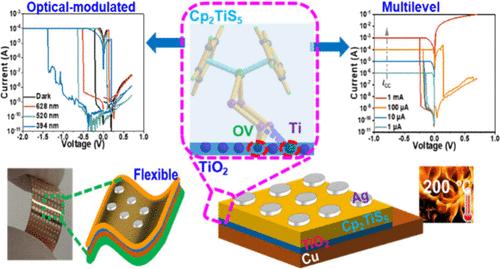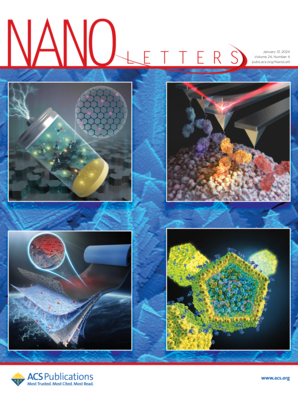Engineering Titanium Dioxide/Titanocene-Polysulfide Interface for Flexible, Optical-Modulated, and Thermal-Tolerant Multilevel Memristor
IF 9.6
1区 材料科学
Q1 CHEMISTRY, MULTIDISCIPLINARY
引用次数: 0
Abstract
Multifunctional memristors with a high memory density, low power consumption, flexibility, programmability, and environmental robustness are essential for next-generation memories. In this work, a titanocene-polysulfide complex (Cp2TiS5) with strong S···S interactions and hydrogen bonds was synthesized and integrated with TiO2 to create a novel Cu/TiO2/Cp2TiS5/Ag memristor. This device shows bipolar nonvolatile memory performance with a remarkable ON/OFF ratio (104.8), low switching voltages (VSET, −0.16 V; VRESET, +0.15 V), and low power consumption (2.7 × 10–4 μW). It exhibits multilevel memory behavior, flexibility, optical modulation (VSET decreases from −1.35 to −0.17 V with decreasing irradiation wavelength), and thermal tolerance (up to 200 °C). The electron-rich Cp2TiS5 layer protects the Ag-CFs, while TiO2’s oxygen vacancies and unsaturated Ti atoms interact with sulfur from Cp2TiS5, lowering the Schottky barrier and facilitating charge transport. This work offers promising opportunities in flexible memristive devices for neuromorphic computing under extreme conditions.

求助全文
约1分钟内获得全文
求助全文
来源期刊

Nano Letters
工程技术-材料科学:综合
CiteScore
16.80
自引率
2.80%
发文量
1182
审稿时长
1.4 months
期刊介绍:
Nano Letters serves as a dynamic platform for promptly disseminating original results in fundamental, applied, and emerging research across all facets of nanoscience and nanotechnology. A pivotal criterion for inclusion within Nano Letters is the convergence of at least two different areas or disciplines, ensuring a rich interdisciplinary scope. The journal is dedicated to fostering exploration in diverse areas, including:
- Experimental and theoretical findings on physical, chemical, and biological phenomena at the nanoscale
- Synthesis, characterization, and processing of organic, inorganic, polymer, and hybrid nanomaterials through physical, chemical, and biological methodologies
- Modeling and simulation of synthetic, assembly, and interaction processes
- Realization of integrated nanostructures and nano-engineered devices exhibiting advanced performance
- Applications of nanoscale materials in living and environmental systems
Nano Letters is committed to advancing and showcasing groundbreaking research that intersects various domains, fostering innovation and collaboration in the ever-evolving field of nanoscience and nanotechnology.
 求助内容:
求助内容: 应助结果提醒方式:
应助结果提醒方式:


